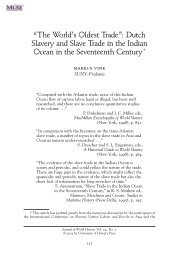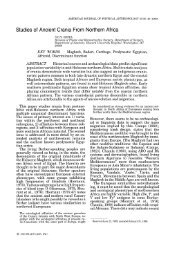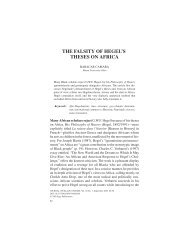Nubian Queens in the Nile Valley and Afro-Asiatic Cultural History
Nubian Queens in the Nile Valley and Afro-Asiatic Cultural History
Nubian Queens in the Nile Valley and Afro-Asiatic Cultural History
You also want an ePaper? Increase the reach of your titles
YUMPU automatically turns print PDFs into web optimized ePapers that Google loves.
N<strong>in</strong>th International Conference for <strong>Nubian</strong> Studies August 20-26, 1998<br />
Museum of F<strong>in</strong>e Arts, Boston U.S.A<br />
Conclud<strong>in</strong>g Remarks:<br />
<strong>Nubian</strong> queens provide suggestive evidence<br />
to be viewed as regents that are a part of possible<br />
larger cultural-historical patterns <strong>in</strong> southwest Asia<br />
<strong>and</strong> nor<strong>the</strong>rn Africa. Some suggested cultural<br />
concomitants, along with o<strong>the</strong>r important roles for<br />
women, can be found <strong>in</strong> <strong>the</strong>se regions where<br />
regnant queens, co-regents, <strong>and</strong> warrior queens<br />
have existed. These <strong>in</strong>clude:<br />
1) greater prom<strong>in</strong>ence of regent queens <strong>in</strong> nonhegemonic<br />
states,<br />
2) matril<strong>in</strong>eality as <strong>the</strong> rule of succession or<br />
significant feature validat<strong>in</strong>g <strong>the</strong> rule of succession<br />
for <strong>the</strong> regency,<br />
3) prom<strong>in</strong>ent roles for o<strong>the</strong>r noble women, for<br />
example, Queen mo<strong>the</strong>rs 4)bro<strong>the</strong>r-sister coregency<br />
as an aspect of matril<strong>in</strong>eal succession,<br />
especially for Sudanic-Ethiopian k<strong>in</strong>gdoms,<br />
5) myths <strong>and</strong> legends of women as founders of<br />
societies or cities,<br />
6) a possible cultural cont<strong>in</strong>uity <strong>in</strong> <strong>the</strong> liv<strong>in</strong>g<br />
tradition <strong>in</strong> Arab-<strong>in</strong>fluenced regions of a "Lady of<br />
Victory" cult where women exhort men <strong>in</strong> battle,<br />
ei<strong>the</strong>r represent<strong>in</strong>g a diffusion of an Arab custom or<br />
a cont<strong>in</strong>uation of pre-Islamic practice.<br />
These suggested cultural patterns for <strong>Afro</strong>-<br />
<strong>Asiatic</strong> queens would <strong>in</strong>clude o<strong>the</strong>r factors that will<br />
be elucidated with fur<strong>the</strong>r research. Free of various<br />
historical biases, exist<strong>in</strong>g sources can be more<br />
objectively assessed, while o<strong>the</strong>r archaeological <strong>and</strong><br />
historical records might be uncovered to shed light<br />
upon <strong>the</strong>se remarkable women as <strong>the</strong>y w<strong>in</strong> <strong>the</strong>ir<br />
place <strong>in</strong> world history.<br />
Carolyn Fluehr-Lobban<br />
Professor of Anthropology<br />
Rhode Isl<strong>and</strong> College<br />
Providence, RI 02908 USA<br />
Email: cfluehr@ric.edu<br />
REFERENCES<br />
7<br />
ABBOTT, N.<br />
1941 - "Pre-Islamic Arab <strong>Queens</strong>." American<br />
Journal of Semitic Languages <strong>and</strong><br />
Literature 18: 1-22.<br />
ADAMS, W. Y.<br />
1994 - "Big Mama at Meroë: Fact <strong>and</strong> Fancy <strong>in</strong><br />
<strong>the</strong> C<strong>and</strong>ace Tradition." Paper presented at<br />
<strong>the</strong> Third International Conference of <strong>the</strong><br />
Sudan Studies Association, Boston.<br />
AIDOO, A. A.<br />
1981 - “Ashante Queen Mo<strong>the</strong>rs <strong>in</strong> Government<br />
<strong>and</strong> Politics <strong>in</strong> <strong>the</strong> N<strong>in</strong>eteenth Century.” In<br />
F. C. Steady, ed., The Black Woman Cross-<br />
<strong>Cultural</strong>ly. Cambridge, MA: 65-77.<br />
BOULDING, E.<br />
1992 - The Underside of <strong>History</strong>. revised<br />
edition, Newbury Park, CA: SAGE<br />
Publications (orig. publ. 1976).<br />
COHEN, S.<br />
1985 - “The Orig<strong>in</strong> of <strong>the</strong> Matril<strong>in</strong>eal Pr<strong>in</strong>ciple<br />
<strong>in</strong> Rabb<strong>in</strong>ic Law.” American Jewish Studies<br />
Review: 19-53.<br />
CONKEY, M.<br />
1993 - “Men <strong>and</strong> Women <strong>in</strong> Prehistory: An<br />
Archaeological Challenge.” In C. Brettell<br />
<strong>and</strong> C. Sargeant, eds., Gender <strong>in</strong> Cross-<br />
<strong>Cultural</strong> Perspective. Englewod Cliffs:<br />
Prentice-Hall.<br />
EIDE, T. - HÄGG, T. - PIERCE, R.H. - TÖRÖK,<br />
L., eds.<br />
1996, - 1998 Fontes Historiae Nubiorum. vols.<br />
II; III. Bergen, Norway, University of<br />
Bergen.<br />
DAUMAS, GEN. E.<br />
1971 - The Ways of <strong>the</strong> Desert. 9 th edition.<br />
Trans. by Sheila M. Ohlendorf. Aust<strong>in</strong>:<br />
University of Texas Press.<br />
FLUEHR-LOBBAN, C.<br />
1979 - “A Marxist Reappraisal of <strong>the</strong><br />
Matriarchate.” Current Anthropology, vol.<br />
20, no.2: 341-58.<br />
1988 - “The Problem of Matril<strong>in</strong>eality <strong>in</strong> Pre-<br />
State <strong>and</strong> Early State Societies.” Paper




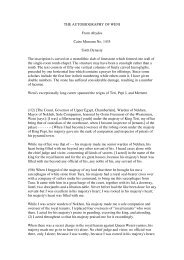
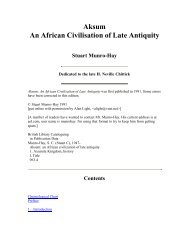
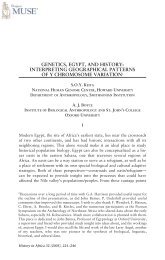

![The Negro trail blazers of California [microform] : a ... - Homestead](https://img.yumpu.com/32436613/1/174x260/the-negro-trail-blazers-of-california-microform-a-homestead.jpg?quality=85)
